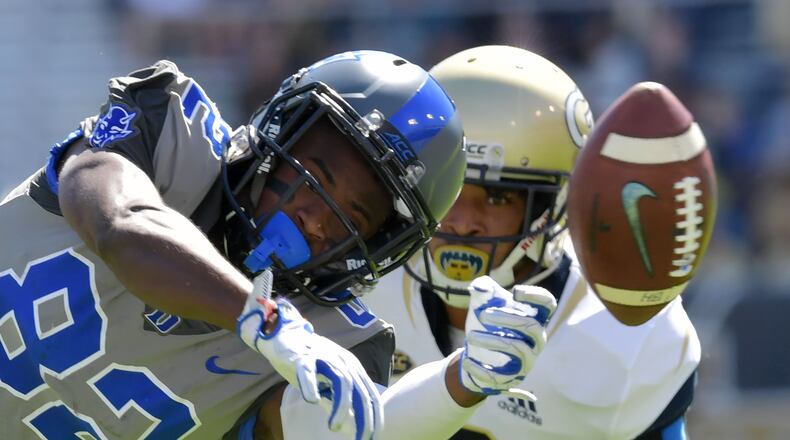There doesn’t seem to be a discernible reason for why Georgia Tech has given up relatively easy scores to start their past two games. It hasn’t been the case for most of the season in defensive coordinator Nate Woody’s first year with the Yellow Jackets.
Regardless, Tech coaches and players are eager to bring an end to the glitch when they play at North Carolina on Saturday, hoping to earn a fifth win and draw one shy of bowl eligibility.
“It’s just we’ve got to tighten up at the beginning,” defensive end Desmond Branch said. “It’s weird that we can’t get it done the first drive. It’s cool that we’re able to tighten up at the end of the game, that we’re able to stop ’em, but giving them that momentum, giving them that hope that they can play with us really puts us behind the 8-ball.”
Two games ago, Duke tore through the Jackets on the game-opening drive. Starting from their 48-yard line after a long kickoff return, the Blue Devils covered 52 yards in four plays to take an early 7-0 lead. The Blue Devils seemed sharper. On the first three plays, Duke quarterback Daniel Jones fired on-target passes to open receivers, once getting off a throw just ahead of a blitz and on another taking advantage of a breakdown in coverage.
However, the Blue Devils were held scoreless over the next seven possessions until a Jackets fumble gave Duke the ball on the Blue Devils’ 43-yard line, setting off a flurry of scores as the Jackets fumbled on three consecutive plays in the 28-14 Duke win.
In the interim, though, Tech made difference-making plays, such as cornerback Tre Swilling’s strip-sack and defensive end Anree Saint-Amour’s pass rush that created an interception, and benefited from Jones losing his touch, perhaps unsettled by the Tech pass rush.
On Thursday against Virginia Tech, the Hokies started the game by moving the ball with ease similar to Duke, powering through the Georgia Tech defense for touchdowns on their first three possessions – 73 yards in five plays, 70 yards in three plays and 73 yards in a comparatively pedestrian 11 plays.
On the opening drive, the Jackets had the Hokies in a third-and-10 and ran a five-man blitz on third down. Better execution on the pass rush may well have led to an incompletion and punt. But the Jackets left a gap in the pocket for quarterback Ryan Willis to escape through to pick up the first down. On the next play, Willis made the Jackets pay. A short slant pass to Tre Turner became a 46-yard touchdown reception when linebacker Jalen Johnson missed a tackle on Turner and in the process took out Swilling.
On the next series, on a first-and-10 at the Jackets 41, Georgia Tech had seven players in pass coverage, and the Hokies sent out only two receivers, but the pass rush couldn’t dent the heavy pass protection and wide receiver Damon Hazelton managed to get behind coverage for a well-executed touchdown. On the third possession, missed tackles abounded as the Hokies drove for a 21-14 lead.
Early on, “they just didn’t play very well,” coach Paul Johnson said of the defense.
But just like that, the faucet ran dry. The tackling improved, and when the Jackets missed tackles, teammates rallied to the ball to cover up. The Hokies made mistakes – dropped passes, a bobbled snap, penalties – and Saint-Amour again made his impact. He made one of the plays of the game, exploiting an apparent missed blocking assignment to drag down Willis on a keeper on a third-and-2 in the third quarter when the Hokies were trying to cut into the Jackets’ 35-21 lead.
After giving up 10.8 yards per play and 21 points over the first three possessions, the Jackets yielded 3.2 yards per play and no points over the next five before Woody began to sub out on Virginia Tech’s final possession.
“I feel like we kind of got off to a bad start and everybody was kind of on their heels and everything,” Saint-Amour said. “We kind of got settled down, saw what they were doing and just did what we had to do.”
The first-possession scores don’t fit into the larger pattern of the season. In Tech’s first six games, opponents scored only once on their first drives, a field goal by Bowling Green. The early scores by Duke and Virginia Tech may well be the result of simple inconsistency that the Jackets have demonstrated, drawing attention only because it has happened twice in a row at an obvious point in the game. No one would notice, for instance, if the Jackets had given up touchdowns on the fourth possessions of games in consecutive games and not the first.
But, Saturday, it would be particularly helpful for the Jackets to start out crisply. Tech could go a long way toward disrupting North Carolina’s plans by stopping its up-tempo offense, getting an early lead and eating up the clock. Playing from behind in a low-possession game is not how the Tar Heels would choose to play.
Further, as is perhaps universally true, the Jackets do better with a lead. Dating to the start of the 2012 season, Tech is 34-13 when it scores first and 12-26 when the opponent does.
“Going against North Carolina, we have to be able to stop their offense in the beginning,” Saint-Amour said.
About the Author
Keep Reading
The Latest
Featured



